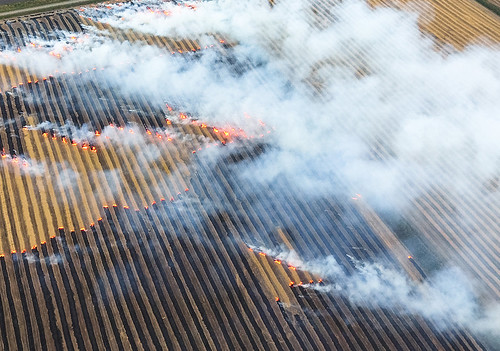A few precautions can reduce risks, impacts of crop residue burns
Aug. 21, 2018
By Fred Miller
U of A System Division of Agriculture
Fast Facts:
- Crop residue burns are useful tools for agricultural management
- Pamphlet of voluntary guidelines helps reduce impacts on air quality and human health
- Department of Agriculture voluntary report line: 1-800-830-8015
(488 words)
Download related PHOTO from Flickr: https://flic.kr/p/NdBboJ
Related website — Arkansas Agriculture Deparment Smoke Management: https://www.agriculture.arkansas.gov/arkansas-voluntary-smoke-management-guidelines
FAYETTEVILLE, Ark. — Autumn in Arkansas farm country is marked by turning leaves, migrating waterfowl and columns of smoke on the horizon.

Crop burning is helpful for managing residue left after harvest, said Jarrod Hardke, extension rice agronomist for the University of Arkansas System Division of Agriculture. Fire helps eliminate insect pests, weeds and diseases, and speeds field preparation for the next growing season.
Counterintuitively, burning can help farmers reduce their carbon footprint by permitting no-till or reduced-till field preparation in the spring, reducing fuel use and potential soil erosion.
Smoke from crop burning, however, can cause hazards when it moves across roads and highways. It can also have negative effects on air quality and pose risks to human health.
Hardke said a little planning and a few precautions can reduce those impacts. “Take weather and wind direction into account and try to keep the smoke away from people and communities,” he said.
Arkansas Voluntary Smoke Management Guidelines for Row Crop Burning, available from the Arkansas Agriculture Department, contains recommendations and helps farmers develop a plan for safe and effective crop burning, Hardke said.
The publication was developed by a smoke management task force that included the Division of Agriculture, the Arkansas Agriculture Department, the Arkansas Rice Research and Promotion Board, the Soybean Promotion Board, Arkansas Deparment of Environmental Quality, the Agriculture Council of Arkansas and Arkansas Farm Bureau.
The information was adapted from the Arkansas Forestry Commission’s Arkansas Voluntary Smoke Management Guidelinesfor forest management. “We adapted the recommendations for row crop burning,” Hardke said.
The booklet also includes the phone number for the Arkansas Agriculture Department’s Dispatch Center, which coordinates prescribed fire activities, reports fire weather and assists with voluntary smoke management.
The number is 1-800-830-8015. The last page of the booklet includes a short checklist of information to have ready when calling, as well as a checklist of recommended precautions.
“I highly recommend landowners call the number before burning off residue,” Hardke said.
Hardke said crop residue needs some time to dry before burning. The guideline booklet recommends a minimum of four days, but Hardke said growers usually want to finish their harvest before burning. The residue often dries a few weeks before being burned.
But farmers have a relatively narrow window between harvest and the start of fall rains for burning, Hardke said.
“If wet weather sets in,” he said, “you’re stuck with it and looking at dealing with it in the spring.”
The trade-off to burning crop residue in the fall is having to till it in the spring, Hardke said. That means a higher expense for fuel, higher risk of erosion and more time needed to prepare for planting. It may also result in higher costs for weed and pest control.
Information about crop burning and smoke management, including a link to downloadArkansas Voluntary Smoke Management Guidelines for Row Crop Burning,can be found on the the Arkansas Agriculture Department website: https://www.agriculture.arkansas.gov/arkansas-voluntary-smoke-management-guidelines
About the Division of Agriculture
The University of Arkansas System Division of Agriculture’s mission is to strengthen agriculture, communities, and families by connecting trusted research to the adoption of best practices. Through the Agricultural Experiment Station and the Cooperative Extension Service, the Division of Agriculture conducts research and extension work within the nation’s historic land grant education system.
The Division of Agriculture is one of 20 entities within the University of Arkansas System. It has offices in all 75 counties in Arkansas and faculty on five system campuses.
Pursuant to 7 CFR § 15.3, the University of Arkansas System Division of Agriculture offers all its Extension and Research programs and services (including employment) without regard to race, color, sex, national origin, religion, age, disability, marital or veteran status, genetic information, sexual preference, pregnancy or any other legally protected status, and is an equal opportunity institution.
Media Contact: Fred Miller
U of A Division of Agriculture
Arkansas Agricultural Experiment Station
(479) 575-5647
fmiller@uark.edu
Related Links